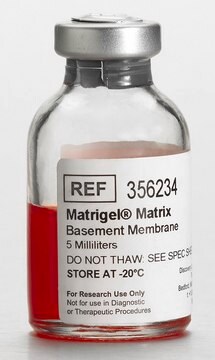E6909
Gel EMC
growth-factor reduced, without phenol red, liquid, BioReagent, suitable for cell culture
Sinonimo/i:
GFR Basement Membrane Extract (BME)
About This Item
Prodotti consigliati
Livello qualitativo
Nome Commerciale
BioReagent
Forma fisica
liquid
Concentrazione
7-9 mg/mL
tecniche
cell culture | mammalian: suitable
Condizioni di spedizione
dry ice
Temperatura di conservazione
−20°C
Informazioni sul gene
mouse ... Hspg2(15530) , Lama1(16772) , Lama3(16774) , Lama5(16776) , Lamb1-1(16777) , Lamc1(226519) , Lamc2(16782) , Nid1(18073) , Sdc2(15529)
Cerchi prodotti simili? Visita Guida al confronto tra prodotti
Applicazioni
Azioni biochim/fisiol
Every mouse colony used for the production of this product is routinely screened for several pathogens. Tested and found negative for LDEV
Componenti
The growth factor reduction modification allows for more control of medium, better interpretation of results and increased polymerization. The medium also lacks phenol red, which can interfere with some analyses.
Avvertenza
Nota sulla preparazione
Codice della classe di stoccaggio
10 - Combustible liquids
Classe di pericolosità dell'acqua (WGK)
WGK 3
Punto d’infiammabilità (°F)
Not applicable
Punto d’infiammabilità (°C)
Not applicable
Certificati d'analisi (COA)
Cerca il Certificati d'analisi (COA) digitando il numero di lotto/batch corrispondente. I numeri di lotto o di batch sono stampati sull'etichetta dei prodotti dopo la parola ‘Lotto’ o ‘Batch’.
Possiedi già questo prodotto?
I documenti relativi ai prodotti acquistati recentemente sono disponibili nell’Archivio dei documenti.
Articoli
Cell culture protocols using Sigma ECM Gel Matrix EHS basement membrane extract (BME) for neurite outgrowth, cell invasion and angiogenesis tube formation assays.
Cell based angiogenesis assays to analyze new blood vessel formation for applications of cancer research, tissue regeneration and vascular biology.
Attachment Factors for 3-Dimensional Cell Culture
Highlighting existing and novel fabrication methods for both, solid and hydrogel-based scaffold for tissue engineering applications.
Il team dei nostri ricercatori vanta grande esperienza in tutte le aree della ricerca quali Life Science, scienza dei materiali, sintesi chimica, cromatografia, discipline analitiche, ecc..
Contatta l'Assistenza Tecnica.








